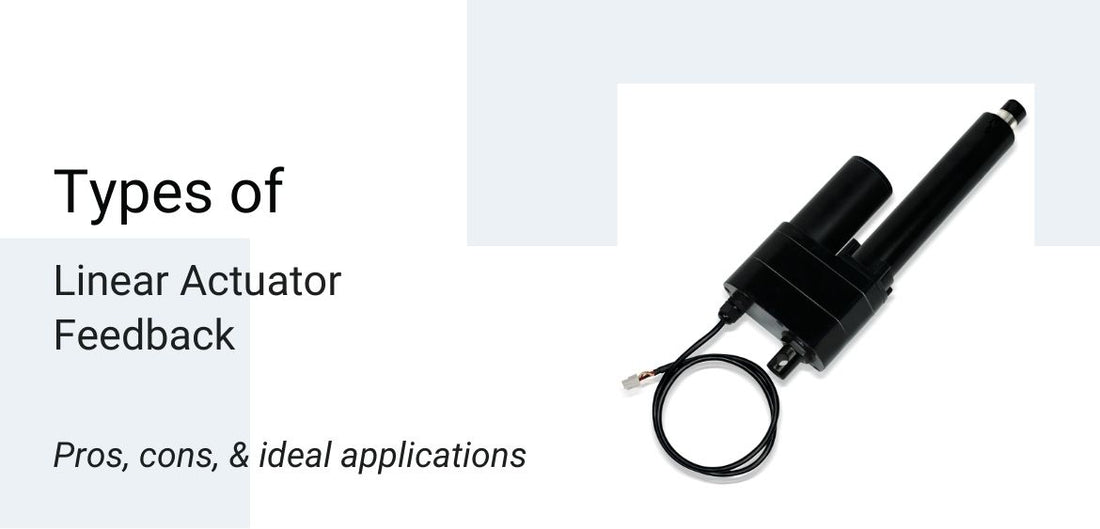The art of motion control is epitomized in linear actuators, which have found applications in numerous areas of life. They used in many areas, from high-tech production lines and smart devices in our homes, to airplanes in the sky. What makes linear actuators exemplary motion control devices? Feedback: the remarkable ability to convey real-time information derived from motion (position, speed, direction) to sophisticated control systems. Controllers use this data to run closed-loop control systems that are capable of achieving exceptional precision in motion delivery, a growing demand of the modern industry. Progressive Automations leads the way with its extensive range of linear actuation products. Our linear actuators are augmented by state of the art feedback systems that make them the best in their class.
This blog discusses various types of linear actuator feedback, such as the physical structures, advantages & disadvantages, and respective applications of each feedback linear actuator.
Linear Actuators with Feedback: Do You Need It?
Having feedback in a motion control device is essential if it is to work in a controlled environment. A linear actuator installed in a standing desk, for example, has a very simple task to perform. It either lifts the workstation or lowers it. This simple operation needs no controlling and thus, such linear actuators never come with feedback mechanisms incorporated in them.
An extension of this case will help illustrate when feedback becomes imperative. Assume you are utilizing linear actuators to lift heavy loads via multiple lifting columns. In such a configuration, the flat surface carrying the load is mounted on each of the lifting columns and has to be kept parallel to the ground to keep the load from falling off.

The lifting columns, in this case, have to work in tandem to prevent the table from tilting even slightly, which can be dangerous. This is a situation in which feedback is absolutely necessary. Each lifting column sends data about its position to the controller, which monitors the extension of each device. If any of the lifting columns are lagging behind or speeding ahead, the controller alters the speeds of all lifting columns to harmonize their movements. This controllability, made possible by feedback, keeps the weight-bearing surface level throughout its operating cycle.
There are multiple types of actuator feedback available: this article will address potentiometers, Hall Effect feedback and limit switch feedback.
Potentiometer Feedback
The simplest version is a linear actuator with potentiometer feedback. Potentiometers are age-old electrical devices that utilize the principle that the electrical resistance of conductive materials is linearly related to its length. Perhaps an easier way to understand this is through a relatable example. We have all used a fan knob to adjust the speed of a fan. This knob is essentially a potentiometer, with a tiny strip of conductive material placed inside it. The position of the knob controls the voltage across the fan’s motor. At one end, or one extreme of its position range, maximum voltage is supplied to the fan, while at the other end, it is minimum. In between, the voltage varies linearly with the position of the knob.
The exact same phenomenon occurs inside a linear actuator with a potentiometer. The rotational range of the knob is analogous to the actuator stroke and the voltage to the motor is analogous to the position of the actuator. The voltage varies smoothly from full retraction to full extension, indicating precisely the position of the actuator. This allows for linear actuator position control.
Advantages & Disadvantages of Potentiometer Feedback
Potentiometers are particularly easy to install in linear actuators and in most cases, the actuator can be retrofitted with a potentiometer later on without any hassle. In addition to this, potentiometers provide an absolute position, that is; they do not need a reference point to convey position. In terms of application, this is a huge benefit as the feedback signal is instantly generated upon startup. In other linear actuators, the actuator must be run through a complete forward and backward stroke to provide reference points to the feedback device. Thus, if you are using a linear actuator for applications that cannot afford this cycle, the potentiometer variant such as our PA-14P is best-suited.
A few drawbacks exist as well. Since the potentiometer has sliding connections on a conductive strip, the potentiometer is susceptible to wear. Moreover, the position signal generated also experiences noise and attenuation in certain cases, which are never desirable.
Hall-Effect Feedback
Hall-effect is a prime choice for using a linear actuator with feedback. This feedback mechanism makes use of a magnet to generate a feedback signal. The working principle behind this technique is a small magnet that is mounted on one of the gears driving the actuator. Placed alongside this gear is a hall-effect sensor, which creates an electrical impulse whenever a magnet passes in front of it. Thus, whenever the magnet passes by the sensor, a position signal is registered in the controller.
Advantages & Disadvantages of Hall-Effect Feedback
The hall-effect feedback mechanism packs a huge benefit in the form of high-resolution feedback. Since the gears in a linear actuator’s gearbox rotate at very high RPMs, the hall-effect sensor shoots a prodigious amount of electrical signals per unit travel of the actuator. This renders the feedback precise and reliable. This is the reason that hall-effect devices like the FLTCON-3 3-Sync Hall Effect Control Box are normally preferred for high-accuracy applications like the aforementioned table lift example.
A demerit of hall-effect sensors is that they need reference values to provide an accurate signal. A homing cycle upon startup is required for this. So, for example, your table lift will rise right up to the top and then to the bottom-most position before you can start working. One must, therefore, keep this in mind before going for hall-effect feedback.
Limit Switch Feedback
Limit switches are a bit different from the feedback mechanisms we discussed above. They are not meant for an electric linear actuator with position feedback, instead, they determine the start and stop points of the linear actuator.
To put it simply, limit switches are installed at both endpoints of the actuator’s stroke and as soon as the actuator rod comes in contact with them, they break off the circuit. This is a necessary measure as the motor does not know when to stop, and if not turned off at endpoints, it can destroy the actuator, itself, or even cause damage to users. The feedback control, in this case, is slightly limited as it is only responsible for collecting position feedback at extreme positions.
Advantages & Disadvantages of Limit Switches
Limit switches are almost universal in the linear actuator industry, with every product having a pair pre-installed. The main advantage of having them is the safety benefit. With limit switches in your linear actuator, you need not worry about burned-out motors, rod bending, overcurrent, structural damage to the application, etc.
As mentioned above, a drawback of having limit switches is that position over the entire stroke cannot be measured. However, this is not an issue is Progressive Automations is your dealer. Our products boast adjustable limit switches that give you control over stroke length and start/end points. Learn how to adjust your stroke length here.

The PA-17 has a set of durable, adjustable limit switches. If you need more within this specification range, the upgraded PA-17 POT is also available with potentiometer feedback to satisfy your technical needs.
Final Thoughts
This blog is aimed to equip you with the necessary knowledge about feedback mechanisms so you can make informed decisions. Hopefully, you can now decide what kind of feedback you need for your motion control applications with this information in mind.
Progressive Automations strives to provide world-class linear actuation products to its clientele. To discuss what feedback should you use, feel free to contact our customer service team.




